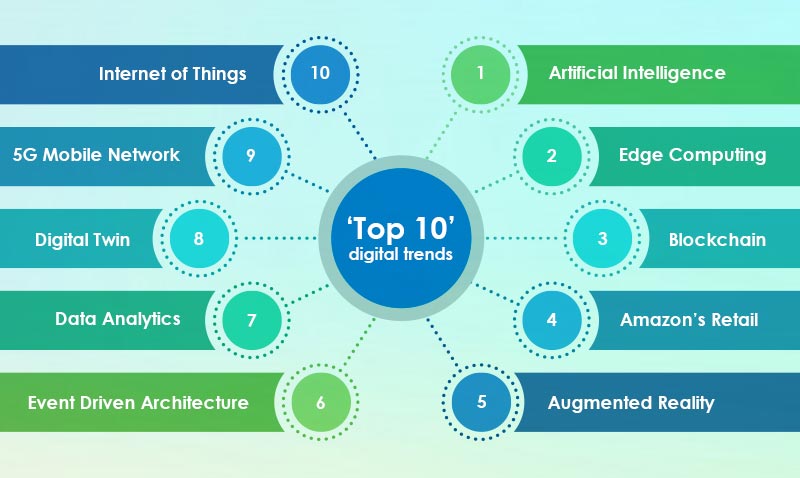Over the last few years, technology has dominated the discussion rooms and continues to be part of the digital transformation journey. While AI and AR have become a norm for many businesses, digital trends are now taking a paradigm shift – for good reasons. Here are our picks of the top digital trends for 2020.
1. Data analytics
Most companies focus on the processing of data in real-time. So, regardless of the industry you’re in, you should embrace digital analytics. It involves examining useful data to increase revenue, optimize efficiencies, save money, and connect with customers. And as more data sources become available, big companies may be forced to develop applications in-house.
Some of the trends in digital analytics include data sourcing, data harvesting using web crawling programs, statistical analysis, and data interpretation.
2. Customer Data Platforms (CDPs)
Customer Data Platforms are gaining more momentum than any other technology. They help to organize real-time customer data across different platforms. A CDP software grasps information from websites and apps and gives a complete view of the customer. That way, businesses can know what needs to be done to specific customers. You can think of CDPs as a prebuilt marketing database with features to standardize and cleanse data.
Some of the benefits of customer data platforms include agility, operational efficiency, the democratization of data, and effective customer experience.
3. Digital Security
Breaches of personal data have been a major concern for many organizations. With the advancement in technology, the number of threats continues to increase. If an organization is faced with a shortage of cybersecurity skills, the gap can be closed with automated security tools. The implementation of cloud technology is also common in 2020.
Companies are also taking serious measures to defend against attacks. This helps to seal the loopholes and give automated response solutions.
4. Connected Clouds
Cloud computing has become a common trend for businesses for the last five years. It doesn’t require intellectual wrangling to understand that it’s now an IT standard. But tech-savvy businesses are paying attention to more than just the obvious.
As modern IT environments become more diverse in pursuit of key business goals, there’s increased automation in multi-cloud settings. And many technologists are aware of the benefits of automation. Businesses are now using connected clouds to manage the complexity of private, public, and hybrid clouds with limited manpower.
That’s not all. Many automation tools allocate specific IP networks and cloud-specific credentials. From 2020 and beyond, connected clouds can automate repetitive tasks at a scale. The providers are also pushing for edge computing.
5. Artificial Intelligence (AI)
Over the years, AI has received a lot of buzzes. It’s known for its superiority for on-demand services. Artificial intelligence has also gained superiority in speech recognition, ride-sharing apps, smartphone personal assistants, etc.
AI also helps to detect changes in consumer behavior and analyzes data in real-time. As artificial intelligence continues to spread its wings across all sectors, jobs are created. This technology has also led to the creation of content creators, data scientists, and automation specialists.
One aspect of artificial intelligence (AI) is the use of Audext. This tool helps to convert audio to text automatically. Also, the transcription software helps to edit the text. Users can even match the speech of the specific speakers.
Audext can help journalists perform interviews without compromising on accuracy. This advanced tool also makes the process less laborious. For instance, you can ask one of your employees to give AI generated transcripts and make a quick edit.
Students can also transcribe lecture notes and voice recordings on their mobile devices. This saves them a lot of hustles.
6. Internet of Things (IoT)
Internet of Things is another promising technology. With so many internet-enabled devices, IoT has become part of us. You’ll find many home appliances that use the internet to exchange data. For example, we can lock our door remotely, track the fitness level, etc. Also, businesses can make better decisions when data is analyzed.
IoT helps to speed up medical care, enable predictive maintenance, and improve customer service. It also offers other benefits that you may never have imagined.
It’s estimated that by 2030, there will be over 50 billion IoT-enabled devices. If you have been on the lookout, new technologies like 5G are slowly driving the market growth.
Final thoughts
We are beginning to see new technologies in the market today. While most of the above concepts may look like the latest buzzwords, they help businesses reap the reward of the digital world. Even those that have been stalling could change in the blink of an eye. Such digital transformations allow companies to compete and outperform.
It’s time you make your business adaptive to the winds of the digital revolution.







.webp)
%20(1).webp)


.webp)